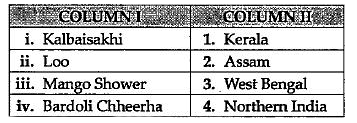Choose the correct reaction:
BaCl2+AcOH+K2CrO4→yellow ppt.
BaCO3(s)+K2C2O4+AcOH→white ppt.
BaCO3(s)+K2CrO4+AcOH→No ppt.
SrCO3(s)+K2CrO4+AcOH→No ppt.
The correct Answer is:A, D
To solve the question regarding the correct reaction among the options provided, we will analyze each reaction step-by-step.
Step 1: Analyze Reaction A
Reaction A: Barium chloride (BaCl2) reacts with acetic acid (CH3COOH) and potassium chromate (K2CrO4).
- Expected Products:
- Barium ions (Ba²⁺) from BaCl2.
- Chromate ions (CrO4²⁻) from K2CrO4.
- Precipitate Formation:
- Barium chromate (BaCrO4) is formed, which is yellow in color.
- Conclusion: This reaction is correct as it produces a yellow precipitate.
Step 2: Analyze Reaction B
Reaction B: Barium carbonate (BaCO3) reacts with potassium chromate (K2CrO4) and acetic acid (CH3COOH).
- Expected Products:
- Barium carbonate is insoluble in acetic acid, but it reacts to produce Ba²⁺ ions.
- Precipitate Formation:
- Ba²⁺ ions react with CrO4²⁻ to form barium chromate (BaCrO4), which is yellow.
- Conclusion: The statement claims a white precipitate is formed, which is incorrect. The reaction produces a yellow precipitate.
Step 3: Analyze Reaction C
Reaction C: Barium carbonate (BaCO3) reacts with potassium chromate (K2CrO4) and acetic acid (CH3COOH).
- Expected Products:
- Similar to Reaction B, BaCO3 reacts to produce Ba²⁺ ions.
- Precipitate Formation:
- Again, Ba²⁺ ions will react with CrO4²⁻ to form yellow barium chromate.
- Conclusion: The statement claims no precipitate is formed, which is incorrect.
Step 4: Analyze Reaction D
Reaction D: Strontium carbonate (SrCO3) reacts with potassium chromate (K2CrO4) and acetic acid (CH3COOH).
- Expected Products:
- Strontium carbonate is insoluble in acetic acid, producing Sr²⁺ ions.
- Precipitate Formation:
- Strontium chromate (SrCrO4) is expected to form, but it does not precipitate due to a higher solubility product (Ksp) compared to barium chromate.
- Conclusion: This reaction is correct as it states no precipitate is formed.
Final Conclusion
The correct reactions are:
- Option A: Barium chloride with acetic acid and potassium chromate produces a yellow precipitate.
- Option D: Strontium carbonate with potassium chromate and acetic acid produces no precipitate.
Summary of Correct Options
- Correct Options: A and D
---
Reaction A: Barium chloride (BaCl2) reacts with acetic acid (CH3COOH) and potassium chromate (K2CrO4).
- Barium ions (Ba²⁺) from BaCl2.
- Chromate ions (CrO4²⁻) from K2CrO4.
- Precipitate Formation:
- Barium chromate (BaCrO4) is formed, which is yellow in color.
- Conclusion: This reaction is correct as it produces a yellow precipitate.
Reaction B: Barium carbonate (BaCO3) reacts with potassium chromate (K2CrO4) and acetic acid (CH3COOH).
- Barium carbonate is insoluble in acetic acid, but it reacts to produce Ba²⁺ ions.
- Precipitate Formation:
- Ba²⁺ ions react with CrO4²⁻ to form barium chromate (BaCrO4), which is yellow.
- Conclusion: The statement claims a white precipitate is formed, which is incorrect. The reaction produces a yellow precipitate.
Reaction C: Barium carbonate (BaCO3) reacts with potassium chromate (K2CrO4) and acetic acid (CH3COOH).
- Similar to Reaction B, BaCO3 reacts to produce Ba²⁺ ions.
- Precipitate Formation:
- Again, Ba²⁺ ions will react with CrO4²⁻ to form yellow barium chromate.
- Conclusion: The statement claims no precipitate is formed, which is incorrect.
Reaction D: Strontium carbonate (SrCO3) reacts with potassium chromate (K2CrO4) and acetic acid (CH3COOH).
- Strontium carbonate is insoluble in acetic acid, producing Sr²⁺ ions.
- Precipitate Formation:
- Strontium chromate (SrCrO4) is expected to form, but it does not precipitate due to a higher solubility product (Ksp) compared to barium chromate.
- Conclusion: This reaction is correct as it states no precipitate is formed.
The correct reactions are:
- Option A: Barium chloride with acetic acid and potassium chromate produces a yellow precipitate.
- Option D: Strontium carbonate with potassium chromate and acetic acid produces no precipitate.
- Correct Options: A and D
Topper's Solved these Questions
- BOOK - VK JAISWAL ENGLISHCHAPTER - QUALITATIVE INORGANIC ANALYSISEXERCISE - MATCH THE COLUMN4videos
QUALITATIVE INORGANIC ANALYSIS
- BOOK - VK JAISWAL ENGLISHCHAPTER - QUALITATIVE INORGANIC ANALYSISEXERCISE - ASSERTION-REASON TYPE QUESTIONS14videos
QUALITATIVE INORGANIC ANALYSIS
- BOOK - VK JAISWAL ENGLISHCHAPTER - QUALITATIVE INORGANIC ANALYSISEXERCISE - LEVEL 362videos
QUALITATIVE INORGANIC ANALYSIS
- BOOK - VK JAISWAL ENGLISHCHAPTER - PERIODIC PROPERTIESEXERCISE - MATCH THE COLUMN11videos
PERIODIC PROPERTIES
- BOOK - VK JAISWAL ENGLISHCHAPTER - s-BLOCK ELEMENTSEXERCISE - SUBJECTIVE PROBLEMS2videos
s-BLOCK ELEMENTS
Similar Questions
Knowledge Check
- Question 1 - Select One
Choose the correct marketing concept:
ATarget market-Customer needs-Profits through customer satisfaction-Integrated marketingBTarget market-Customer needs-Integrated marketing-Profits through customer satisfactionCCustomer needs-Target market-Integrated marketing-Profits through customer satisfactionDTarget market-Integrated marketing-Customer needs-Profits through customer satisfaction - Question 2 - Select One

Choose the correct option:Ai-2, ii-1, iii-4, iv-3Bi-3, ii-4, iii-1, iv-2Ci-2, ii-3, iii-4, iv-1Di-1, ii-2, iii-4, iv-3


_CHE_E06_278.png) Choose the correct option.
Choose the correct option.